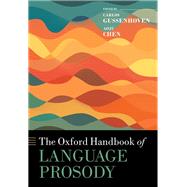- ISBN: 9780192568205 | 0192568205
- Cover:
- Copyright: 2/24/2021
Carlos Gussenhoven, Professor of General and Experimental Phonology, Radboud University Nijmegen,Aoju Chen, Professor of Language Development in Relation to Socialisation and Identity, Utrecht University
Carlos Gussenhoven is Professor of General and Experimental Phonology at Radboud University, Nijmegen, where he held a personal chair from 1996 to 2011. He has held positions at UC Berkeley, Queen Mary University of London, and National Chiao Tung University, as well as well as guest professorships at the University of Konstanz and Nanjing University. His many publications include Understanding Phonology (4th ed, with Haike Jacobs; Routledge 2017) and The Phonology of Tone and Intonation (CUP, 2004).
Aoju Chen is Professor of Language Development in Relation to Socialisation and Identity at Utrecht University. She has worked extensively on the production, perception, and processing of prosodic meaning and acquisition of prosody in a first and second language from a cross-linguistic perspective. More recently, she has extended her work to research on the social impact of developing language abilities in a first or second language. She is currently an associate editor of Laboratory Phonology and an elected board member of the ISCA Special Interest Group on Speech Prosody (SPoSIG).
1. Introduction, Carlos Gussenhoven and Aoju Chen
Part I: Fundamentals of Language Prosody
2. Articulatory measures of prosody, Taehong Cho and Doris M?cke
3. Fundamental aspects in the perception of f0, Oliver Niebuhr, Henning Reetz, Jonathan Barnes, and Alan C.L. Yu
Part II: Prosody and Linguistic Structure
4. Tone systems, Larry M. Hyman and William R. Leben
5. Word-stress systems, Matthew K. Gordon and Harry van der Hulst
6. The Autosegmental-Metrical theory of intonation phonology, Amalia Arvaniti and Janet Fletcher
7. Prosodic morphology, John J. McCarthy
8. Sign language prosody, Wendy Sandler, Diane Lillo-Martin, Svetlana Dachkovsky, and Ronice M?ller de Quadros
Part III: Prosody in Speech Production
9. Phonetic variation in tone and intonation systems, Jonathan Barnes, Hansj?rg Mixdorff, and Oliver Niebuhr
10. Phonetic correlates of word and sentence stress, Vincent J. van Heuven and Alice Turk
11. Speech rhythm and timing, Laurence White and Zofia Malisz
Part IV: Prosody across the World
12. Sub-Saharan Africa, Larry M. Hyman, Hannah Sande, Florian Lionnet, Nicholas Rolle, and Emily Clem
13. North Africa and the Middle East, Sam Hellmuth and Mary Pearce
14. South West and Central Asia, Anastasia Karlsson, G?liz G?neş, Hamed Rahmani, and Sun-Ah Jun
15. Central and Eastern Europe, Maciej Karpiński, Bistra Andreeva, Eva Liina Asu, Anna Daugavet, Štefan Benuš, and Katalin M?dy
16. Southern Europe, Mariapaola D'Imperio, Barbara Gili Fivela, Mary Baltazani, Brechtje Post, and Alexandra Vella
17. Iberia, S?nia Frota, Pilar Prieto, and Gorka Elordieta
18. Northwestern Europe, Tomas Riad and J?rg Peters
19. Varieties of English, Martine Grice, James Sneed German, and Paul Warren
20. The North Atlantic and the Arctic, Kristj?n ?rnason, Anja Arnhold, Ailbhe N? Chasaide, Nicole Deh?, Amelie Dorn, and Osahito Miyaoka
21. The Indian Subcontinent, Aditi Lahiri and Holly J. Kennard
22. China and Siberia, Jie Zhang, San Duanmu, and Yiya Chen
23. Mainland Southeast Asia, Marc Brunelle, James Kirby, Alexis Michaud, and Justin Watkins
24. Asian Pacific Rim, Sun-Ah Jun and Haruo Kubozono
25. Austronesia, Nikolaus P. Himmelmann and Daniel Kaufman
26. Australia and New Guinea, Brett Baker, Janet Fletcher, and Mark Donohue
27. North America, Gabriela Caballero and Matthew K. Gordon
28. Mesoamerica, Christian DiCanio and Ryan Bennett
29. South America, Thiago Costa Chacon and Fernando O. de Carvalho
Part V: Prosody in Communication
30. Meanings of tones and tunes, Matthijs Westera, Daniel Goodhue, and Carlos Gussenhoven
31. Prosodic encoding of information structure: A typological perspective, Frank K?gler and Sasha Calhoun
32. Prosody in discourse and speaker state, Julia Hirschberg, Štefan Benuš, Agust?n Gravano, and Rivka Levitan
33. Visual prosody across cultures, Marc Swerts and Emiel Krahmer
34. Pathological prosody: overview, assessment, and treatment, Diana Van Lancker Sidtis and Seung-yun Yang
Part VI: Prosody and Language Processing
35. Cortical and subcortical processing of linguistic pitch patterns, Joseph C.Y. Lau, Zilong Xie, Bharath Chandrasekaran, and Patrick C.M. Wong
36. Prosody and spoken-word recognition, James M. McQueen and Laura C. Dilley
37. The role of phrase-level prosody in speech production planning, Stefanie Shattuck-Hufnagel
Part VII: Prosody and Language Acquisition
38. The acquisition of word prosody, Paula Fikkert, Liquan Liu, and Mitsuhiko Ota
39. Development in phrase-level prosody from infancy to late childhood, Aoju Chen, N?ria Esteve-Gibert, Pilar Prieto, and Melissa A. Redford
40. Prosodic bootstrapping, Judit Gervain, Anne Christophe, and Reiko Mazuka
41. Prosody in infant- and child-directed speech, Melanie Soderstrom and Heather Bortfeld
42. Prosody in children with atypical development, Rhea Paul, Elizabeth Schoen Simmons, and James Mahshie
43. Word prosody in L2, Allard Jongman and Annie Tremblay
44. Sentence prosody in a second language, J?rgen Trouvain and Bettina Braun
45. Prosody in L2 teaching: methodologies and effectiveness, Dorothy M. Chun and John M. Levis
Part VIII Prosody in Technology and the Arts
46. Prosody in automatic speech processing, Anton Batliner and Bernd M?bius
47. Automatic prosody labeling and assessment, Andrew Rosenberg and Mark Hasegawa-Johnson
48. Stress, meter, and text-setting, Paul Kiparsky
49. Tone-melody matching in tone language singing, D. Robert Ladd and James Kirby
References
Index of languages
Index of subjects
The New copy of this book will include any supplemental materials advertised. Please check the title of the book to determine if it should include any access cards, study guides, lab manuals, CDs, etc.
The Used, Rental and eBook copies of this book are not guaranteed to include any supplemental materials. Typically, only the book itself is included. This is true even if the title states it includes any access cards, study guides, lab manuals, CDs, etc.
Digital License
You are licensing a digital product for a set duration. Durations are set forth in the product description, with "Lifetime" typically meaning five (5) years of online access and permanent download to a supported device. All licenses are non-transferable.
More details can be found here.






